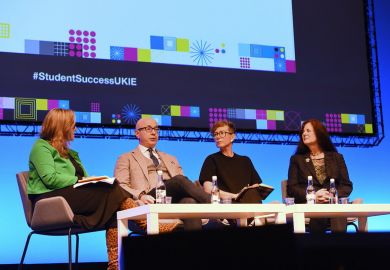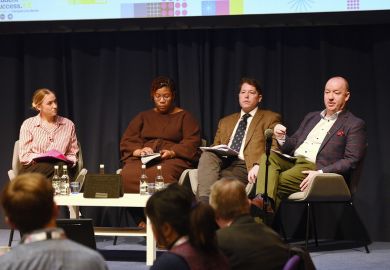The “dull” layout of university classrooms and lecture halls may be holding back more innovative styles of teaching, one of the UK’s newest vice-chancellors has argued.
Liz Barnes, who took the reins at Staffordshire University at the start of this month, told the Times Higher Education Young Universities Summit at Pompeu Fabra University in Barcelona that she was keen to introduce more teaching spaces at her institution that encourage peer-to-peer interaction and use of tablet devices in class.
While she commended some of the newly refurbished teaching spaces at Staffordshire, which include some classrooms with glass walls, many of the classroom spaces were “dull and do not reflect the kind of space I would like to see”, said Professor Barnes on 7 April, who joined Staffordshire from Sheffield Hallam University, where she was deputy vice-chancellor.
“The room that an academic walks into shapes the way they teach,” Professor Barnes said. “The natural configuration of any classroom should be groups, not rows of seats.”
This idea also applied to lecture theatres where rows of fixed seating did not encourage students to interact with each other, Professor Barnes explained. At Sheffield Hallam, seats that could be turned into either direction had fostered more conversations between students, she added.
“We lost about 30 seats but this only impacted on 26 sessions in a year,” she said.
University classrooms should also be designed to allow students to plug in their laptops and tablets, which could then become part of teaching, Professor Barnes explained.
“Nottingham Trent University has made sure they have rooms like this in every one of their buildings,” she said, adding that employers expected computer literacy to be a standard skill held by graduates, with one major international company even recruiting trainees solely through Instagram.
Professor Barnes also praised the use of open plan offices in universities, saying she had rejected a proposed vice-chancellor’s office at Staffordshire in favour of a shared space.
“I believe in open spaces,” said Professor Barnes, although she added that the introduction of such designs at Sheffield Hallam had been only partially successful when it was first trialled.
“It hadn’t been thought through and staff used filing cabinets and coat racks to block themselves off from each other,” she said.
Her appeal for more innovative use of university space was echoed by Peter Coaldrake, vice-chancellor and president at Queensland University of Technology, where larger lecture theatres were being adapted into smaller areas for teaching its 50,000 students.
“We are decommissioning lecture theatres everywhere,” said Professor Coaldrake, whose institution in Brisbane will host next year’s Young Universities Summit.
“Lecture theatres for 400 to 500 people are being replaced by flat areas designed for 40 to 50 people,” he said.
POSTSCRIPT:
Print headline: Spice up those ‘dull’ classrooms, new v-c urges
Register to continue
Why register?
- Registration is free and only takes a moment
- Once registered, you can read 3 articles a month
- Sign up for our newsletter
Subscribe
Or subscribe for unlimited access to:
- Unlimited access to news, views, insights & reviews
- Digital editions
- Digital access to THE’s university and college rankings analysis
Already registered or a current subscriber?








